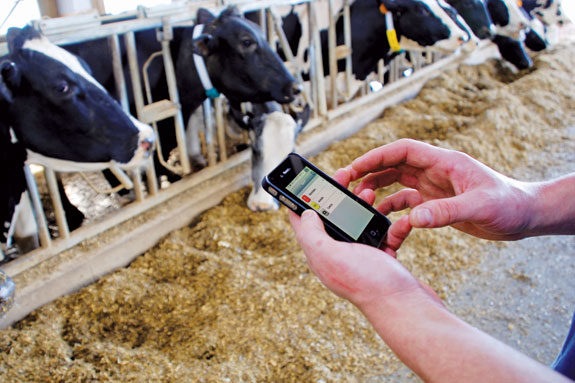Individual-cow activity monitors have helped many dairies improve their heat detection rates in recent years. By tracking increased levels of cow activity, the monitors help producers identify animals in the initial stages of estrus, which can lead to more timely insemination, reduced reproductive hormone expense and improved pregnancy rates.
But can these monitors do even more for dairies?
With so much focus being placed on high activity levels, it is important to remember that cows on the other end of the spectrum – those exhibiting lower-than-normal activity – can be signaling their own management needs.
Research shows that low activity precedes disease
Low activity can be a telling indication of disease onset. Sick or lame cows may start reducing their trips to the feedbunk and water trough before they exhibit clinical signs like limping, fever, irregular milk composition or abnormal uterine discharge.
By detecting these animals early in the disease process, interventions can be made to treat animals promptly, administer other supportive care and hopefully minimize the impact of the disease incident.
A team of Canadian researchers from the University of British Columbia, collaborating with colleagues at the University of Guelph, have conducted a number of research studies examining the relationship between behavior changes and the incidence of prevalent dairy disease conditions.
Activity-monitoring studies also have been performed recently by researchers at Virginia Tech University. Among their findings:
• Metritis: The Canadian researchers found that cows with post-calving metritis infections showed less activity in the dry period before they calved – and before they exhibited any clinical disease symptoms.
They spent less time feeding and engaging in aggressive behavior at the feedbunk and consumed less feed and water than their herdmates that remained healthy.
Cows in the study were almost three times more likely to be diagnosed with metritis for every 2.2-pound decrease in dry matter intake the week before calving.
• Ketosis: Results from the same study showed that, compared with healthy cows, animals that developed subclinical ketosis after calving spent less time feeding, ate less feed and displayed less aggressive behavior at the feedbunk during the week before calving.
In the same animals, a 2.2-pound decrease in dry matter consumption resulted in a 2.2 times greater risk of subclinical ketosis.
The Virginia Tech researchers found that cows experiencing subclinical ketosis displayed increased rest bouts on the day prior to disease diagnosis and decreased daily steps six days before the disease was diagnosed.
• Milk fever: At Virginia Tech, they found cows with milk fever displayed more rest bouts with decreased daily steps on the day prior to and the day after disease diagnosis, and engaged in increased overall rest throughout the disease period.
• Mastitis: It has long been a belief that the longer cows stand after milking, the more thoroughly the teat sphincter muscle is able to close and the lower the risk of bacterial penetration of the teat orifice once cows lie down.
Making fresh feed available as cows exit the parlor has been promoted to encourage this standing behavior. University of Guelph researchers found that there is an ideal “window” of post-milking standing time.
When cows stood for more than 60 minutes post-milking, their odds of acquiring new, subclinical environmental infections began to climb. The researchers speculate that this may be due to resumed milk accumulation causing increased mammary system pressure and greater access to invasive bacteria.
The researchers suggest monitoring cows to detect both those that lie down too early after milking and those that stand for extended periods of time.
• Lameness: In a study conducted by the University of British Columbia team, they found that cows that developed sole lesions and ulcers in mid-lactation spent more time standing during the two weeks prior to and 24 hours after calving compared to cows that experienced no hoof health problems.
They also found these cows that developed hoof problems spent more time “perching” halfway in the stall compared to healthy cows before calving, while spending the same amount of time standing in all other parts of the pen. Corrections in stocking density or stall design might remedy these behaviors.
How activity monitoring can help
Activity-monitoring systems were initially installed to help herds detect estrous behavior conveyed by higher levels of activity. But they also can detect periods of significantly lower activity, which could help identify cows on the brink of illness.
And in the case of some conditions like mastitis and lameness, the activity reports could signal behaviors that can be corrected through management to prevent disease episodes altogether.
Specific behaviors also can be evaluated via the data provided by these systems, such as standing time after milking.
Low activity could be an indicator of a variety of disease conditions and does not specifically diagnose the problem. But the information can trigger action to physically identify and examine flagged cows to assess their condition and treat them accordingly.
As more research is conducted, it may become possible to more accurately pinpoint which disease condition is impending.
The herd veterinarian, nutritionist and other advisers can help develop strategies for monitoring priorities and set protocols for the steps taken when low-activity cows are identified.
An important consideration in utilizing low-activity monitoring is whether an activity monitor will be placed on every cow in the herd, including dry cows and possibly springing heifers.
Herds that use the monitors strictly for heat detection typically need only about half as many units as cows in the herd because the tags are removed when cows are confirmed pregnant.
Purchasing units for 100 percent of the herd will save labor in transferring tags and eliminate the chance that animals will be missed. (Or information corruption, moving tags on large facilities is a big job, etc.)
Our experience has shown that many farms benefit from tagging 100 percent of the herd. These dairies simply have better data collection, can better manage their herd and make informed, timely decisions not only about breeding, but overall animal health. PD
PHOTO
Low activity could be an indicator of a variety of disease conditions and does not specifically diagnose the problem. But the information can trigger action to physically identify and examine flagged cows to assess their condition and treat them accordingly. Photo courtesy of GEA Farm Technologies.

James Bringe
Activity Monitoring Consultant
GEA Farm Technologies






